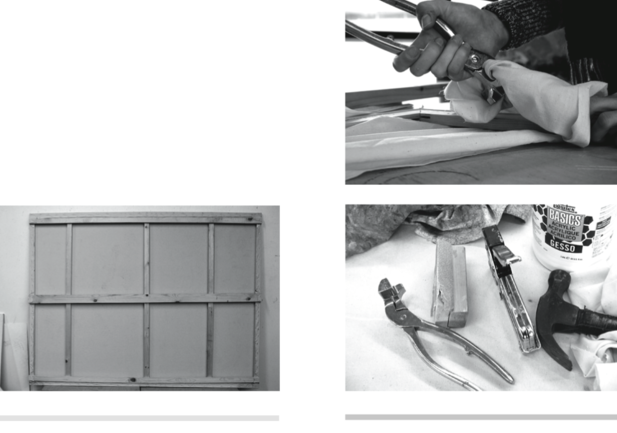“If I could say it in words there would be no reason to paint.”

“If I could say it in words there would be no reason to paint.”



[1] construction 1: stabilizing
the canvas foundation is built from 2x wooden pieces. each corner is met with 45 degree angles and joined at a right angle. two 2x6 and one 4x6 pieces protrude outward to cage reinforcing vertical pieces that slip behind and nestle into this squared junction.
[2] construction 2: stretching canvas
there is a certain sound that perfectly tightened and stretched canvas makes; it is the drum of painting. there is a slight bounce when the hand or brush marks the cloth. the process starts from the four middles of the outer bars, the cardinal points, and works its way outward in rhythmic jumping from one axis to the other; first, stretching creates triangles at the corners that slowly bend and flatten into the perfect horizontal plane.
[3] construction 3: wrapping corners and seaming edges
corners do not always look inwardly toward their opposite being. they may circle the canvas, never glancing back. they may completely cover the ends of wooden backing or allow for a slight revelation of the other type of corner, the hard one of wood. here the corner-folds wrap half of their being to reveal the other half as wood in a coexistence of equality and sharing, signifying their mutual relience on one another for strength and stability. when ends of canvas edges are tucked and seamed, they reveal a finished edge that mimics the hard edge of its wooden partner.
[4] sequence 4: gesso and sanding smooth
gesso provides the substantial base for oils to sit instead of
soak. basing with a tone of grey draws out better color relationships for the eye. sanding is a tactile process, insuring that brushes will not grind against small , lifted pieces of cloth.
[5] sequence 5: mixing
the science of painting is a careful and complex process. color is a visual directional vocabulary. when neutrals converse with the bold, a vibrancy intensifies the bold’s presence. Pure hues express a great meaning on their own, but it is most beautiful and exciting when colors interact in communal spaces.